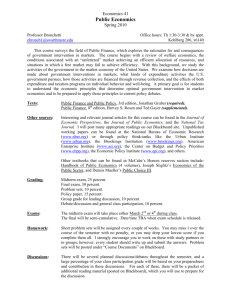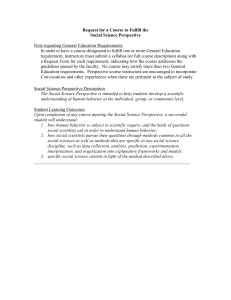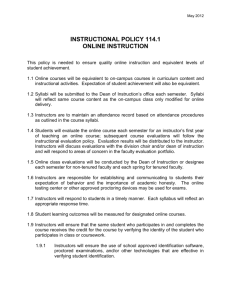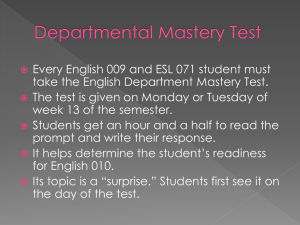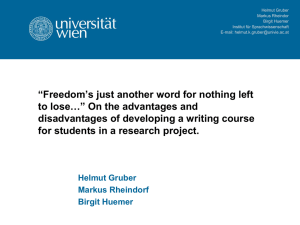In her essay “Re: Ways We Contribute: Students, Instructors, and
advertisement
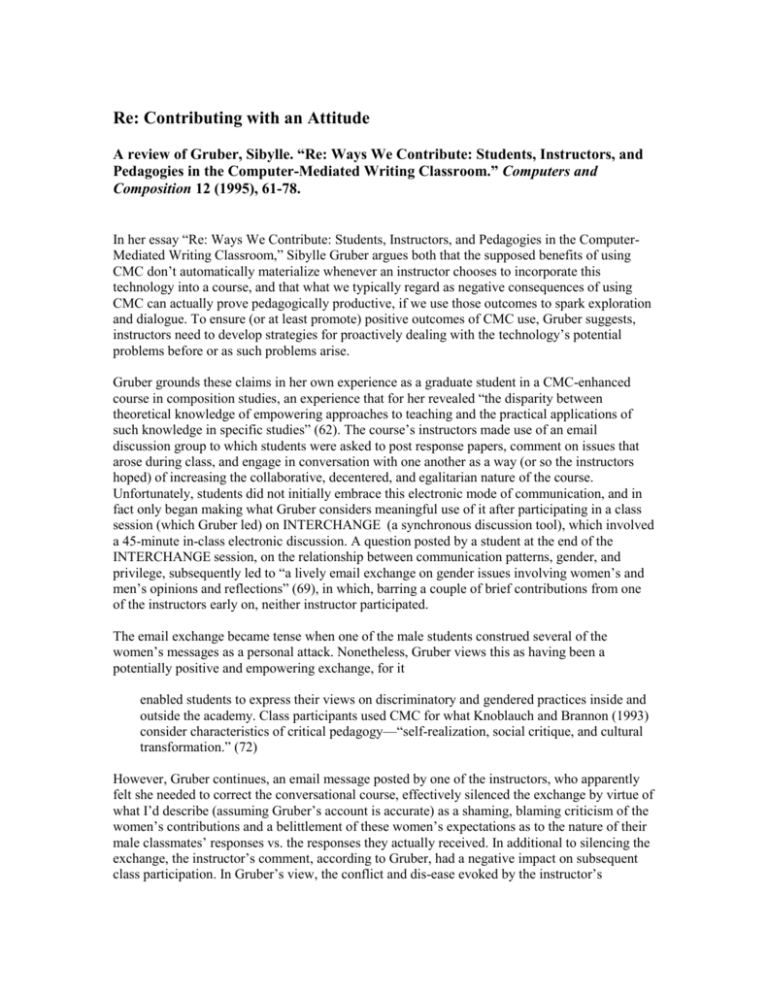
Re: Contributing with an Attitude A review of Gruber, Sibylle. “Re: Ways We Contribute: Students, Instructors, and Pedagogies in the Computer-Mediated Writing Classroom.” Computers and Composition 12 (1995), 61-78. In her essay “Re: Ways We Contribute: Students, Instructors, and Pedagogies in the ComputerMediated Writing Classroom,” Sibylle Gruber argues both that the supposed benefits of using CMC don’t automatically materialize whenever an instructor chooses to incorporate this technology into a course, and that what we typically regard as negative consequences of using CMC can actually prove pedagogically productive, if we use those outcomes to spark exploration and dialogue. To ensure (or at least promote) positive outcomes of CMC use, Gruber suggests, instructors need to develop strategies for proactively dealing with the technology’s potential problems before or as such problems arise. Gruber grounds these claims in her own experience as a graduate student in a CMC-enhanced course in composition studies, an experience that for her revealed “the disparity between theoretical knowledge of empowering approaches to teaching and the practical applications of such knowledge in specific studies” (62). The course’s instructors made use of an email discussion group to which students were asked to post response papers, comment on issues that arose during class, and engage in conversation with one another as a way (or so the instructors hoped) of increasing the collaborative, decentered, and egalitarian nature of the course. Unfortunately, students did not initially embrace this electronic mode of communication, and in fact only began making what Gruber considers meaningful use of it after participating in a class session (which Gruber led) on INTERCHANGE (a synchronous discussion tool), which involved a 45-minute in-class electronic discussion. A question posted by a student at the end of the INTERCHANGE session, on the relationship between communication patterns, gender, and privilege, subsequently led to “a lively email exchange on gender issues involving women’s and men’s opinions and reflections” (69), in which, barring a couple of brief contributions from one of the instructors early on, neither instructor participated. The email exchange became tense when one of the male students construed several of the women’s messages as a personal attack. Nonetheless, Gruber views this as having been a potentially positive and empowering exchange, for it enabled students to express their views on discriminatory and gendered practices inside and outside the academy. Class participants used CMC for what Knoblauch and Brannon (1993) consider characteristics of critical pedagogy—“self-realization, social critique, and cultural transformation.” (72) However, Gruber continues, an email message posted by one of the instructors, who apparently felt she needed to correct the conversational course, effectively silenced the exchange by virtue of what I’d describe (assuming Gruber’s account is accurate) as a shaming, blaming criticism of the women’s contributions and a belittlement of these women’s expectations as to the nature of their male classmates’ responses vs. the responses they actually received. In additional to silencing the exchange, the instructor’s comment, according to Gruber, had a negative impact on subsequent class participation. In Gruber’s view, the conflict and dis-ease evoked by the instructor’s comment were never resolved; thus, a sense of betrayal and distrust replaced the more open (if tension-producing) quality of the peer email exchange. In response to this experience, Gruber quite rightly suggests that “it would be premature to characterize [CMC] technology as ‘liberatory’ and ‘egalitarian’ if we are not prepared to use CMC in connection with a teaching approach conducive to diversity and change” (74). Following her description of the silencing email incident, Gruber devotes the remainder of her article to suggesting pedagogical strategies that do encourage diversity and change in a computermediated course. Such strategies include Openly and explicitly discussing one’s pedagogical approach as a way of gaining buy-in (or at least understanding) on the rationale behind CMC course activities and requirements. Further encouraging a dialogical environment by insisting on shared student–instructor responsibility for the course outcome. Giving students advance notice about the potential problems and conflicts associated with computer-mediated communication, and introducing problem-solving and conflict resolution strategies as such problems and conflicts arise. Gruber’s insightful conclusion to the article is best stated in her own words: Instructors and students have to be aware that CMC has the potential to increase conflict and cause anxieties even if it is used in connection with a carefully planned and critically appropriated pedagogy. However, if such a pedagogy allows for a critical discussion of conflict situations, and if CMC is seen connection with a liberatory pedagogy, the increased tensions and anxieties do not necessarily translate into insurmountable problems. CMC can be seen as a forum that raises issues; however, it is the users’ responsibility to resolve these issues and use them for constructive criticism of injustices based on discriminatory practices against members of the academic, social, and political community. (77) * * * Interestingly, although I find Gruber’s argument entirely convincing in terms of content, my “reader response” to her article is ultimately charged with a sense of doubt, for reasons that move well beyond (or beneath) content. As I read the article, I found myself wondering whether in writing it the author might have had some additional unacknowledged (maybe even unconscious) agenda, possibly having to do with her own seemingly unresolved issues with the course and its instructors. I admire Gruber for courageously naming and analyzing a problematic situation, and I appreciate the instructors’ apparent willingness to be publicly evaluated in this way (for I assume Gruber wrote this with their agreement if not their collaboration). I also know how painful the failure—if indeed the two instructors’ perception of the situation and its outcomes coincides with Gruber’s—must have been; and so I wonder why it is that Gruber chose not to acknowledge their views on the experience in some way. I want to remind readers that experiences of failure or even of unintended outcomes which result from pedagogical risk-taking are as much a part of the teaching learning curve as hind-sight analysis (Monday morning quarterbacking?) is. In other words, while I fully agree with Gruber’s analysis and recommendations concerning the necessity of designing a pedagogy that is consistent with one’s goals for technology use, I would, in reading her essay, also have welcomed a little more positive acknowledgement of the two Gruber Review—p. 2 instructors who, after all, were at least willing to try something new—and/or I would have liked to hear something of their non-author-mediated voices in here as well.* I am concerned that Gruber’s text may have some negative repercussions in terms of furthering the use of CMC technology in composition classrooms. After all, how many instructors, presented with the opportunity to try new pedagogical approaches and methodologies, opt not to do so for fear of exactly the kind of unfriendly public exposure of a teaching failure that Gruber’s article represents? *I re-read the article several times in search of clues that Gruber had engaged in any kind of dialogue with the instructors about her experience in the classroom or her writing of this essay, but could find no such indications. For me, the absence of any real acknowledgment of the instructors’ perspectives lends an underlying spiteful tone to the essay. Tracy Ann Robinson WR 520—Computers and Composition Oregon State University Dept. of English 5/7/02 Gruber Review—p. 3

